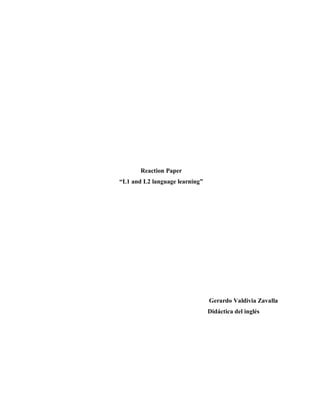
Reaction paper - "L1 and L2 language learning"
- 1. Reaction Paper “L1 and L2 language learning” Gerardo Valdivia Zavalla Didáctica del inglés
- 2. Summary Cook’s paper, “First and second language learning”, is a comparison between L1 and L2 language learning, the different factors and the differences that can be considered in an educational context in the acquisition of a first and second language, the paper expresses an overall position, stating similarities between L1 and L2 learning. The paper presents eight statements which put the attention to the setting of the learning, specially the context; the motivations that the learner, in order to acquire a new language; the mental capacity of the learner; the adaptation of language in particular situations and in the interaction of child with peers. Freeman(2004) “Essential Linguistics, What you need to know to teach reading, ESL, Spelling, Phonics, Grammar”, chapter one: “First language acquisition”, suggests some views of first language acquisition focused on the child, according to Rice (2002), the model of language development should be focus on the children needs and what motivates them ; on the environment, because the language always occurs in a context and what people say depend on the context; and on the language, Chomsky(1968) stated that language is innate in children, he and other linguists argued that “it is the best way to account for the fact that nearly all humans develop the ability to use a very complex linguistic system in a short time” . The second chapter, “Written and second language acquisition” Krashen (1981) believes that the learning in schools is not really acquired, students just learn the form; Schumann claims that social factors, motivations, attitude and cultural shocks explain the rate in acquisition of a language; moreover, Schumann added that children appear to be better L2 because adults are expected to learn a language and use it correctly, but children have more time to acquire it.
- 3. Evaluation The Author’s presentation was well done and prepared. Cook’s eight statements gave examples to explain in a better way the meaning of the statements and how L1 and L2 have similarities acquiring a language. His reasoning was clear and supported by others authors. In freeman’s chapters one and two the information was well delivered to the reader. The quality of the reasoning was right, the evidence, examples and citations of other authors were good and explicative. On one hand, the arguments were supported by the necessary evidence, sometimes when the evidence was not clear the author clear it up by examples. On the other hand when in some points the answers were not conclusive because of the lack of research they stated that clearly. The arguments were persuasive, since they were supported by some researches and researchers which rapidly persuade the reader. When there was lack or no researches at all on a specific topic the authors explained that there were certain evidence but that in any case it meant a certain prove. In the topic that people have motivations, attitudes and cultural issues to learn a second language, it would be really important to research about why they think that and figure out how to change that feeling in order to improve the attitude and motivations towards the English acquisition. Teachers have a really important role in the acquiring of a new language, in how to make students understand the importance of knowing their first language or mother tongue because that gives them the background knowledge of the component of the languages such as nouns and verbs. For instance to L2 learners, this it gives them more tools to acquire the language because they know their own grammar and syntax, etc. A mind changing was that it is believed that people should learn a language, but the fact is that they should acquire it, not just learn it and not using it, it is important that teacher make students to use the language in real context not just in the school. By using the language, this it is being acquiring. In conclusion, L1 and L2 have similarities in acquiring a language; the arguments on texts were conclusive and understandable. Motivation has an important role in the acquisition of a language. Teachers also have a role of importance in changing the motivation for students to learn a language and that L2 learners have advantages acquiring a language because they know the rules of their own language.
- 4. References Freeman . D, & Freeman, Y. (2004). Essential Linguistics What you need to know to teach reading, ESL, Spelling, Phonics, Grammar. Heinemann. Krashen, S. (1981). “Second Language Acquisition and Second Language Learning”. University of Southern California. V.J. Cook, J. Long and S. McDonough. In G.E. Perren (Ed.). (1979). The Mother Tongue and Other Languages in Education, CILTR. Cook. V. (3 Ed) (2011). Second Language Learning and Language Teaching. Chomsky. N . (1968). Language and the mind.
